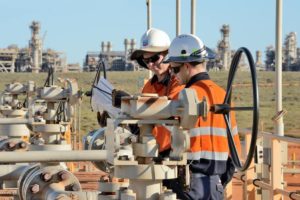The federal and South Australia governments have finalised their funding deal for what they expect to be one of the biggest green hydrogen hubs in the country, but there is still no word on the land-mark tender for a green hydrogen electrolyser and power plant in Whyalla.
The federal government is to pitch $70 million, and the state government $30 million into infrastructure – such as works on the massive jetty – to support the Port Bonython Hydrogen Hub near Whyalla, which is expected to bring in some $13 billion of investment and become a major green hydrogen export hub.
The proposal is backed by a huge number of international and local companies, including potential Asian hydrogen buyers, and major renewable and storage developers, as well as hydrogen technology providers.
The funding deal confirmation was formally announced during a visit to Whyalla by prime minister Anthony Albanese and state premier Malinauskas.
What remains missing is the anticipated results of the tender for $600 million of state funded projects at that city, including the 250MW hydrogen electrolyser and a 200MW hydrogen power plant.
The results of that tender had been expected as early as July, but have been gradually pushed back. The latest announcement by the government is for early October, which will make the already ambitious timeline for the projects – to be built by the end of 2025 – even tighter.
The Port Bonython hub is expected to bring in huge licks of private investment, with the aim to generate as much as 1.8 million tonnes of hydrogen a year by 2030.
“There such available land there, there’s abundant solar and wind resources, South Australia is primed to become a world class, low cost hydrogen supplier,” Albanese said in a radio interview on Monday morning.
Port Bonython is located around 16kms from the industrial city of Whyalla and hopes a deep-water port, and a huge jetty currently used by Santos for gas shipments and others, including for diesel imports.
The federal government is currently finalising the details of its $2 billion Hydrogen Head Start program, designed to address some of the capital flight concerns caused by the success of initiative under the US Inflation Reduction Act, and it is also reviewing its national hydrogen strategy, to focus on the more realistic parts of the hydrogen economy.
Albanese said in an earlier statement that Australian is investing over half a billion dollars for regional hydrogen hubs including in Pilbara, Kwinana, Gladstone, Townsville, the Hunter, Bell Bay and Upper Spencer Gulf.
The government expects that, by 2050, Australia’s hydrogen industry is projected to generate $50 billion in additional GDP and create over 16,000 jobs in regional Australia. “The global shift to clean energy and decarbonised economies is a huge economic opportunity for Australia,” he said.
The growth of hydrogen, and electrification of industry, transport and buildings, will be important for South Australia as it continues its transition to become the first grid of its scale in the world to operate with net 100 per cent variable renewables.
Already in the past year it has sourced more than 70 per cent of its local demand from wind and solar alone, and expects this to rise to “net 100 per cent” in coming years. Over the weekend,
rooftop solar alone met more than 100 per cent of local demand – the first time this has occurred in the state, and anywhere in the world.










